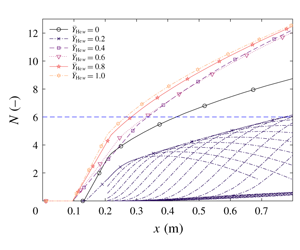Article contents
Injection-gas-composition effects on hypersonic boundary-layer transition
Published online by Cambridge University Press: 10 March 2020
Abstract

The thermal protection system in atmospheric-entry and hypersonic-cruise vehicles are oftentimes designed to ablate during their operation, thus injecting a mixture of various gases with distinct properties into the boundary layer. Such outgassing affects the propagation of instabilities within the boundary layer that ultimately originates the transition to turbulence. This work uses linear stability theory, in combination with the e $^{N}$ method, to establish the underlying reason for the experimentally observed advancement/delay of transition in sharp slender hypersonic cones, when injecting lighter/heavier gases. Contrary to the current understanding and experimental correlations, this numerical analysis suggests that such a behaviour is not linked to the isolated effect of the injected gas’ molar weight, but to its combination with the blowing discontinuity, porosity and the appearance of a shocklet, consequence of the injected gas composition. The shocklet constitutes a density gradient that acts on second-mode instabilities like a thermoacoustic impedance.
$^{N}$ method, to establish the underlying reason for the experimentally observed advancement/delay of transition in sharp slender hypersonic cones, when injecting lighter/heavier gases. Contrary to the current understanding and experimental correlations, this numerical analysis suggests that such a behaviour is not linked to the isolated effect of the injected gas’ molar weight, but to its combination with the blowing discontinuity, porosity and the appearance of a shocklet, consequence of the injected gas composition. The shocklet constitutes a density gradient that acts on second-mode instabilities like a thermoacoustic impedance.
- Type
- JFM Rapids
- Information
- Copyright
- © The Author(s), 2020. Published by Cambridge University Press
References
- 9
- Cited by




